Anyone interested in history but especially those interested in military history should take the time to explore Old San Juan’s two historic forts. Spanning decades of construction, both Castillo San Felipe del Morro and Castillo de San Cristóbal are open for the public to freely wander.
It doesn’t matter from which direction you approach Castillo San Felipe del Morro (501 Calle Norzagaray, Old San Juan, 787/729-6777, daily 9am-6pm, free, orientation talks every hour on the hour in English and Spanish), it’s an impressive sight to behold. From San Juan Bay, which was constructed to protect from attack, it’s an awesome feat of engineering and a daunting display of military defense featuring four levels of cannon-bearing batteries that rise 140 feet from the sea. From Old San Juan, the approach is more welcoming, thanks to an enormous expanse of grassy lawn and breathtaking views of the shore. It’s easy to see why this is such a popular spot for kite-flyers.

Castillo San Felipe del Morro. Photo © Suzanne Van Atten.
Inside Castillo San Felipe del Morro is a maze of rooms, including gun rooms, soldiers’ quarters, a chapel, turreted sentry posts, and a prison connected by tunnels, ramps, and a spiral stairway.Inside Castillo San Felipe del Morro is a maze of rooms, including gun rooms, soldiers’ quarters, a chapel, turreted sentry posts, and a prison connected by tunnels, ramps, and a spiral stairway. The foundations for El Morro were laid in 1539, but it wasn’t completed until 1787. It successfully endured many foreign attacks by the English in 1595, 1598, and 1797, and by the Dutch in 1625. During the Spanish-American War, the United States fired on El Morro and destroyed the lighthouse, which was later rebuilt.On Saturdays and Sundays, guided tours are offered in Spanish and English.
Castillo de San Cristóbal (Calle Norzagaray at the entrance to Old San Juan, 787/729-6777, daily 9am-6pm, $5) is the large fortress at the entrance to Old San Juan by Plaza de Colón. Before it was built, two significant attacks from land—first by the Earl of Cumberland in 1598, later by the Dutch in 1625—convinced the Spanish that protecting the walled city from attack by sea alone was not adequate.
The fort’s construction began in 1634 and was completed in 1783. The fort eventually encompassed 27 acres of land, although some of it was destroyed to accommodate the expanding city. The fort’s defense was tested in 1797 by another unsuccessful attack by the British. After the United States won the Spanish-American War, it took control of the fort and used it as a World War II observation post. Today, a section of the fort is open to the public, who can wander freely among its intriguing array of tunnels, ramps, stairways, batteries, magazines, soldiers’ quarters, and turreted sentry posts.
Excerpted from the Fourth Edition of Moon Puerto Rico.